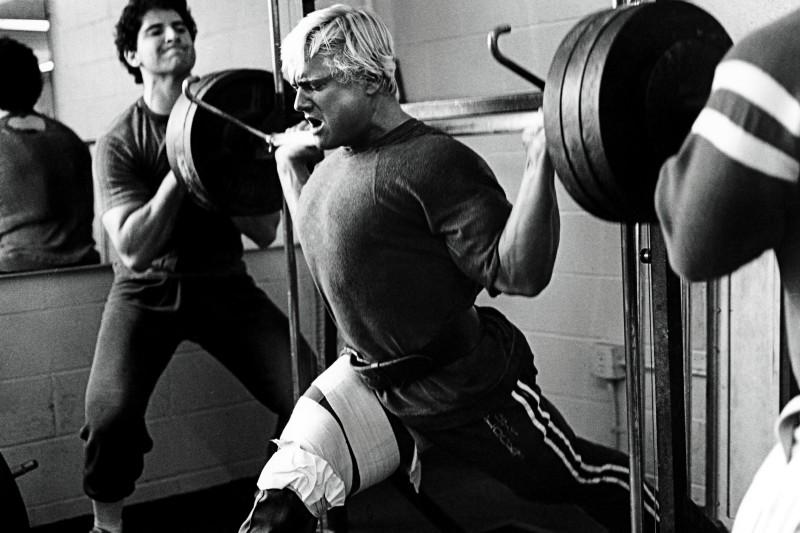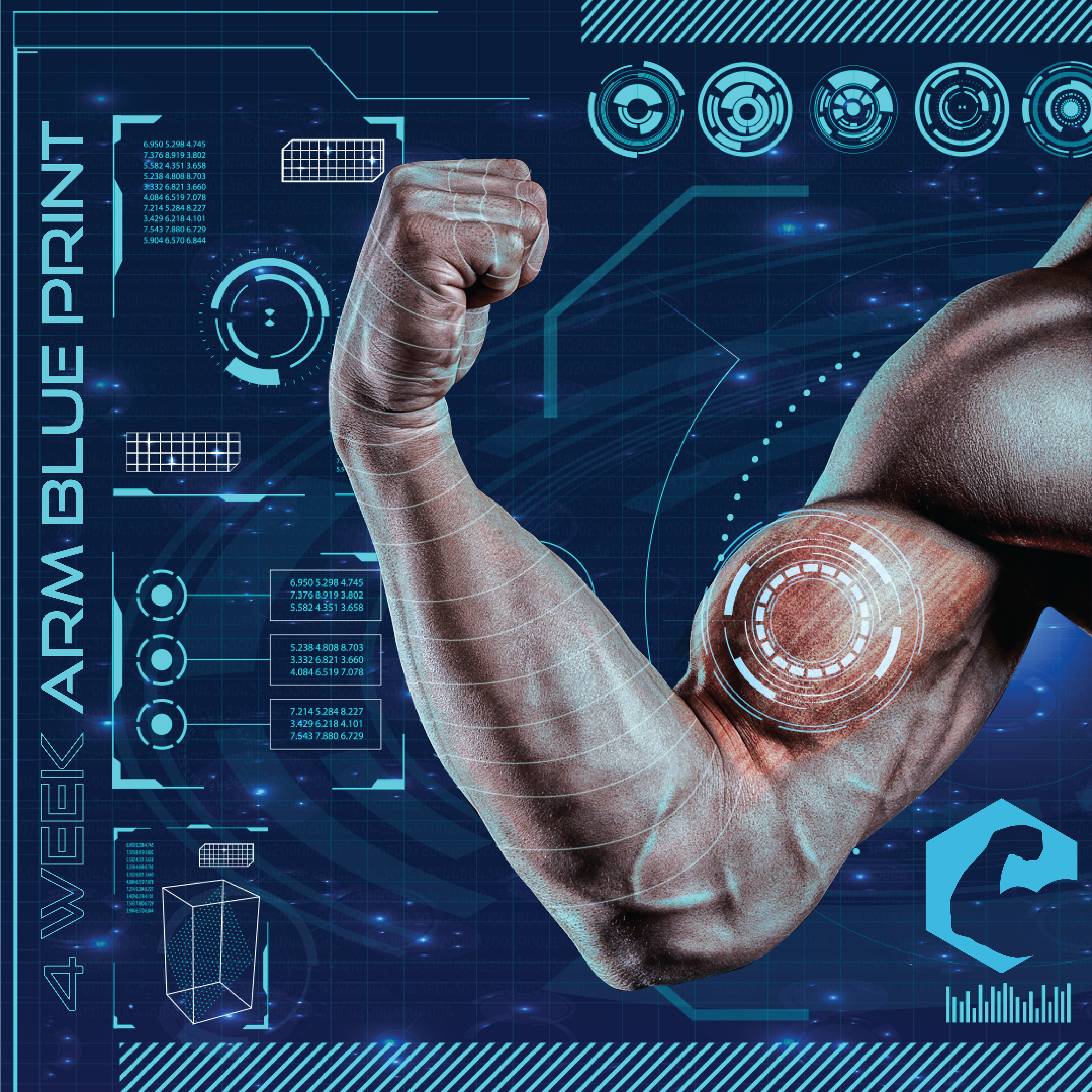Introduction
A popular refrain in the fitness community is that eccentric contractions are more important for muscle growth than concentric contractions. We often hear trainers and coaches tout the importance of the, “negative,” during lifts and how controlling it slowly will enhance growth. It’s easy to get people to buy into this theory as eccentric contractions typically induce more muscle damage (19) and more soreness which people often associate with gains. Is the eccentric portion of a lift really more effective for gains? Let’s check it out.
Eccentrics and Research
 The first thing to point out is that several studies have shown that eccentric-only training causes more muscle growth than concentric-only training (5,9,11,16). However, we see something curious in the vast majority of studies that show greater growth during eccentric-only training: most protocols use more resistance during eccentric-only training! Why is this? A muscle can produce anywhere from 25-50% more force during the eccentric portion of a lift compared to the concentric (1). Researchers take this information and apply greater loads to eccentric-only training to account for this difference, seeing as how, say, 80% of an eccentric 1RM would be a much greater load than 80% of a concentric 1RM.
The first thing to point out is that several studies have shown that eccentric-only training causes more muscle growth than concentric-only training (5,9,11,16). However, we see something curious in the vast majority of studies that show greater growth during eccentric-only training: most protocols use more resistance during eccentric-only training! Why is this? A muscle can produce anywhere from 25-50% more force during the eccentric portion of a lift compared to the concentric (1). Researchers take this information and apply greater loads to eccentric-only training to account for this difference, seeing as how, say, 80% of an eccentric 1RM would be a much greater load than 80% of a concentric 1RM.
We know that mechanical tension is the primary driver of muscle growth (20). The amount of tension a fiber experiences is equal to the force it is producing – which is mostly dependent on muscle activation and contraction speed – both of which are influenced by weight. Therefore, studies using greater weights during eccentric-only protocols compared to concentric-only are simply inducing more mechanical tension on the muscle during the eccentric than the concentric – which will obviously lead to greater growth!
When studies examine the same load between eccentric and concentric contractions, there’s no difference in muscle growth (2,6,12,13,14). If we take away the increase in mechanical tension seen in the other studies, eccentrics no longer have an advantage to induce greater growth.
Normal Training
Now, think about normal resistance training. You slap 225lbs on a bar and start repping it out – is the weight increasing during the eccentric component? Not a chance. So are you getting a greater growth stimulus out of the negative? No! When considering normal training, there’s no benefit to, “focusing on the negative,” because when the same weight is used throughout the whole range of motion, there’s no additional mechanical tension on the eccentric to promote growth. Now, this doesn’t mean that you should just let the weight crash down during the negative; control is still necessary for several reasons, but going extremely slow won’t have any extra benefit.
So now what’s the takeaway? There’s a few more things we have to discuss before we can really shut the door on this discussion. First, we need to go over the difference in muscle activation during eccentric and concentric contractions when using the same load for both – since that’s what happens during normal training.
Concentric vs Eccentric Contractions and Growth
In a normal lift, muscle activation will actually decrease during the eccentric portion and increase during the concentric portion (1,17). This is largely due to the Size Principle, which states that motor units are activated in order from small to large depending on the demand placed on the muscle – this is still respected during eccentric contractions (3). Since a muscle can produce 25-50% more force during the eccentric portion, fewer large motor units have to be activated compared to the concentric portion where more motor units have to be activated to produce force (17). Increasing motor unit activation means that more muscle fibers are active, and more active fibers means more fibers are experiencing tension! Large motor units, or high threshold motor units, are also the primary motor units that respond to exercise by growing, so increasing their activation is huge for growth.
Furthermore, when considering a normal lift, think about how fatigue affects barbell velocity. When someone is getting near failure on a certain lift, we see the barbell drop very quickly during the eccentric and raise very slowly during the concentric. This is another interesting observation when considering the Force-Velocity curve. The Force-Velocity curve states that a muscle produces more force at slow contraction velocities during the concentric portion, while force remains pretty consistent at all velocities during eccentric actions. Remember, force is equivalent to tension which is key for growth. So, during fatiguing conditions, a muscle will actually start producing more force during the concentric due to the change in contraction velocity. This means, again, that a muscle is experiencing more tension during the concentric portion than the eccentric when considering a normal lift.
 Lastly, another potential stimulus for hypertrophy is metabolic stress, which refers to the accumulation of metabolites during fatiguing exercise. This accumulation can induce cell swelling which can increase protein synthesis and individual metabolites themselves might even act as growth signals (20). Why is this important? Well, a muscle is about twice as energy efficient during an eccentric contraction compared to a concentric contraction (15). This means that very little metabolic stress occurs during the eccentric portion and that the vast majority occurs during the concentric.
Lastly, another potential stimulus for hypertrophy is metabolic stress, which refers to the accumulation of metabolites during fatiguing exercise. This accumulation can induce cell swelling which can increase protein synthesis and individual metabolites themselves might even act as growth signals (20). Why is this important? Well, a muscle is about twice as energy efficient during an eccentric contraction compared to a concentric contraction (15). This means that very little metabolic stress occurs during the eccentric portion and that the vast majority occurs during the concentric.
Is Growth Specific to Contraction Type?
So when considering muscle activation, fatigue, and metabolic stress, it almost sounds like concentric contractions are more important than eccentric contractions for growth when weight is the same between both. That may or may not be the case, but it’s very much worth pointing out that both types of contractions are very important for gains. Studies have actually shown that eccentric and concentric contractions induce different types of hypertrophy on the muscle (1). Since eccentrics involve fiber lengthening, longitudinal hypertrophy typically occurs where the muscle fiber increases in length. On the other hand, concentric contractions appear to more so induce myofibrillar hypertrophy where muscle fibers increase in diameter (7). Why is this the case?
We know that mass cannot be created or destroyed; it’s one of the universal laws of the world. So why do your biceps look bigger when you flex in the mirror? A muscle fiber will have to retain its volume at all times, so when it shortens during a sick front double biceps pose, it’s going to bulge and make the muscle look bigger. On the opposite end of the spectrum, when a muscle lengthens, its diameter will actually decrease since volume has to be maintained with length increasing. This change in fiber shape is one of the ways that the mechanoreceptors in a muscle can detect tension. Therefore, the growth response to specific types of contractions appears to align with what type of fiber deformation they cause (1). For more information on the different types of hypertrophy that each contraction can induce, check out Dr. Chris Beardsley’s article here for a more in-depth look.
Conclusion
Alright, alright, so really, what is the takeaway here? When you’re performing normal training with barbells, dumbbells, machines, whatever – the weight is not going to change between the eccentric and concentric. Therefore, there’s not a specific portion of the lift that’s more important than the other! Yes, controlling the negative is important, but that’s more so for safety than gains as that’s not going to net you any extra benefit. If you truly want to get benefits of real eccentric training, you’re going to have to perform eccentrics with well over 100% of your 1RM to actually challenge this contraction mode. This is certainly possible, but it’s dangerous and requires plenty of training experience plus solid equipment and spotters as you won’t be able to lift the weight concentrically by yourself. Also, keep in mind that this method will cause a ton of muscle damage. Too much muscle damage can actually decrease muscle fiber size (8) and impair training frequency – neither of which are desirable by bodybuilders.
 At the end of the day, both the eccentric and concentric portions of a lift are equally important. Let your form, fatigue level, and the weight dictate the tempo with which you lift. There’s no need to preferentially focus on the negative portion of the lift if you’re using the same weight throughout the range of motion. If you do want to perform real eccentrics, use at least 110% of your 1RM and lower it as slowly as possible. Shoot for at least 10-seconds during the negative to maximize mechanical tension. Next time you hear someone talk about how important the negative portion of a lift is, feel free to tell them exactly how wrong they are and how they’re misinterpreting the implications of scientific studies. Actually, don’t do that. But feel free to point them here for a full discussion on the topic!
At the end of the day, both the eccentric and concentric portions of a lift are equally important. Let your form, fatigue level, and the weight dictate the tempo with which you lift. There’s no need to preferentially focus on the negative portion of the lift if you’re using the same weight throughout the range of motion. If you do want to perform real eccentrics, use at least 110% of your 1RM and lower it as slowly as possible. Shoot for at least 10-seconds during the negative to maximize mechanical tension. Next time you hear someone talk about how important the negative portion of a lift is, feel free to tell them exactly how wrong they are and how they’re misinterpreting the implications of scientific studies. Actually, don’t do that. But feel free to point them here for a full discussion on the topic!
References
- Beardsley, C. (2018). Do eccentric and concentric training produce different types of muscle growth? Retrieved from: https://medium.com/@SandCResearch/do-eccentric-and-concentric-training-produce-different-types-of-muscle-growth-ec66197b0f5c
- Cadore, E. L., González‐Izal, M., Pallarés, J. G., Rodriguez‐Falces, J., Häkkinen, K., Kraemer, W. J., … & Izquierdo, M. (2014). Muscle conduction velocity, strength, neural activity, and morphological changes after eccentric and concentric training. Scandinavian Journal of Medicine & Science in Sports, 24(5), e343-e352.
- Chalmers, G. R. (2008). Can fast-twitch muscle fibres be selectively recruited during lengthening contractions? Review and applications to sport movements. Sports Biomechanics, 7(1), 137-157.
- Clarkson, P. M., Byrnes, W. C., McCormick, K. M., Turcotte, L. P., & White, J. S. (1986). Muscle soreness and serum creatine kinase activity following isometric, eccentric, and concentric exercise. International Journal of Sports Medicine, 7(03), 152-155.
- Farthing, J. P., & Chilibeck, P. D. (2003). The effects of eccentric and concentric training at different velocities on muscle hypertrophy. European Journal of Applied Physiology, 89(6), 578-586.
- Farup, J., Rahbek, S. K., Vendelbo, M. H., Matzon, A., Hindhede, J., Bejder, A., … & Vissing, K. (2014). Whey protein hydrolysate augments tendon and muscle hypertrophy independent of resistance exercise contraction mode. Scandinavian Journal of Medicine & Science in Sports, 24(5), 788-798.
- Franchi, M. V., Wilkinson, D. J., Quinlan, J. I., Mitchell, W. K., Lund, J. N., Williams, J. P., … & Narici, M. V. (2015). Early structural remodeling and deuterium oxide‐derived protein metabolic responses to eccentric and concentric loading in human skeletal muscle. Physiological Reports, 3(11).
- Foley, J. M., Jayaraman, R. C., Prior, B. M., Pivarnik, J. M., & Meyer, R. A. (1999). MR measurements of muscle damage and adaptation after eccentric exercise. Journal of Applied Physiology, 87(6), 2311-2318.
- Friedmann, B., Kinscherf, R., Vorwald, S., Müller, H., Kucera, K., Borisch, S., … & Billeter, R. (2004). Muscular adaptations to computer‐guided strength training with eccentric overload. Acta Physiologica Scandinavica, 182(1), 77-88.
- Gibala, M. J., MacDougall, J. D., Tarnopolsky, M. A., Stauber, W. T., & Elorriaga, A. (1995). Changes in human skeletal muscle ultrastructure and force production after acute resistance exercise. Journal of Applied Physiology, 78(2), 702-708.
- Higbie, E. J., Cureton, K. J., Warren III, G. L., & Prior, B. M. (1996). Effects of concentric and eccentric training on muscle strength, cross-sectional area, and neural activation. Journal of Applied Physiology, 81(5), 2173-2181.
- Jones, D. A., & Rutherford, O. M. (1987). Human muscle strength training: the effects of three different regimens and the nature of the resultant changes. The Journal of Physiology, 391(1), 1-11.
- Mayhew, T. P., Rothstein, J. M., Finucane, S. D., & Lamb, R. L. (1995). Muscular adaptation to concentric and eccentric exercise at equal power levels. Medicine and Science in Sports and Exercise, 27(6), 868-873.
- Moore, D. R., Young, M., & Phillips, S. M. (2012). Similar increases in muscle size and strength in young men after training with maximal shortening or lengthening contractions when matched for total work. European journal of Applied Physiology, 112(4), 1587-1592.
- Nielsen, J. S., Madsen, K., Jørgensen, L. V., & Sahlin, K. (2005). Effects of lengthening contraction on calcium kinetics and skeletal muscle contractility in humans. Acta Physiologica Scandinavica, 184(3), 203-214.
- Norrbrand, L., Fluckey, J. D., Pozzo, M., & Tesch, P. A. (2008). Resistance training using eccentric overload induces early adaptations in skeletal muscle size. European Journal of Applied Physiology, 102(3), 271-281.
- Pasquet, B., Carpentier, A., & Duchateau, J. (2006). Specific modulation of motor unit discharge for a similar change in fascicle length during shortening and lengthening contractions in humans. The Journal of Physiology, 577(2), 753-765.
- Ryschon, T. W., Fowler, M. D., Wysong, R. E., Anthony, A. R., & Balaban, R. S. (1997). Efficiency of human skeletal muscle in vivo: comparison of isometric, concentric, and eccentric muscle action. Journal of Applied Physiology, 83(3), 867-874.
- Schoenfeld, B. J., Ogborn, D. I., Vigotsky, A. D., Franchi, M. V., & Krieger, J. W. (2017). Hypertrophic effects of concentric vs. eccentric muscle actions: a systematic review and meta-analysis. The Journal of Strength & Conditioning Research, 31(9), 2599-2608.
- Wackerhage, H., Schoenfeld, B. J., Hamilton, D. L., Lehti, M., & Hulmi, J. J. (2018). Stimuli and sensors that initiate skeletal muscle hypertrophy following resistance exercise. Journal of Applied Physiology, 126(1), 30-43.
From being a mediocre athlete, to professional powerlifter and strength coach, and now to researcher and writer, Charlie combines education and experience in the effort to help Bridge the Gap Between Science and Application. Charlie performs double duty by being the Content Manager for The Muscle PhD as well as the Director of Human Performance at the Applied Science and Performance Institute in Tampa, FL. To appease the nerds, Charlie is a PhD candidate in Human Performance with a master’s degree in Kinesiology and a bachelor’s degree in Exercise Science. For more alphabet soup, Charlie is also a Certified Strength and Conditioning Specialist (CSCS), an ACSM-certified Exercise Physiologist (ACSM-EP), and a USA Weightlifting-certified performance coach (USAW).




